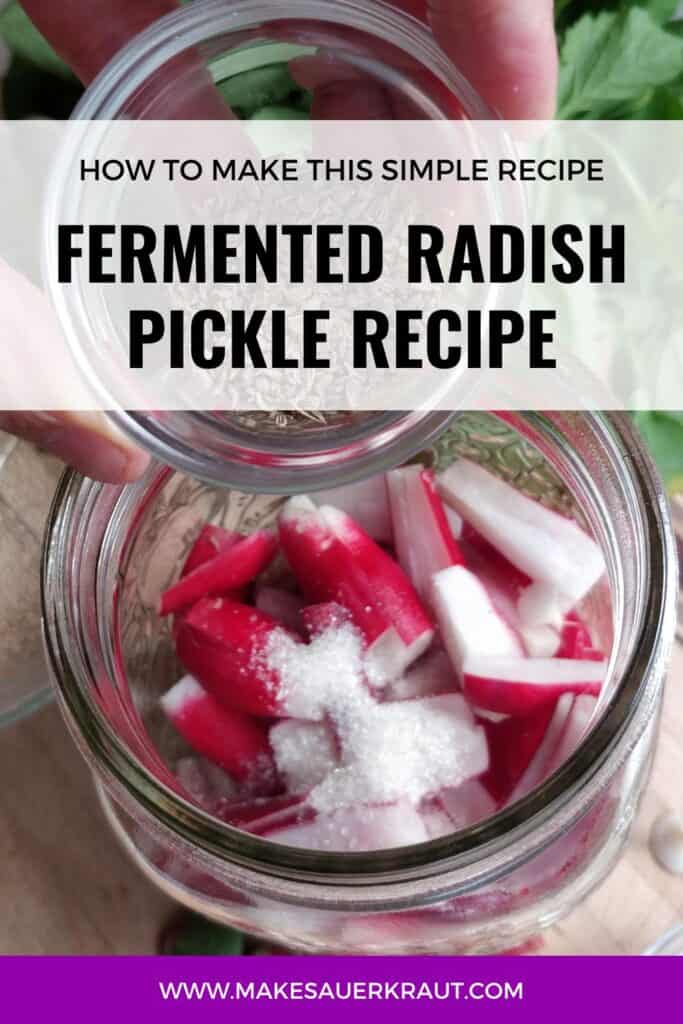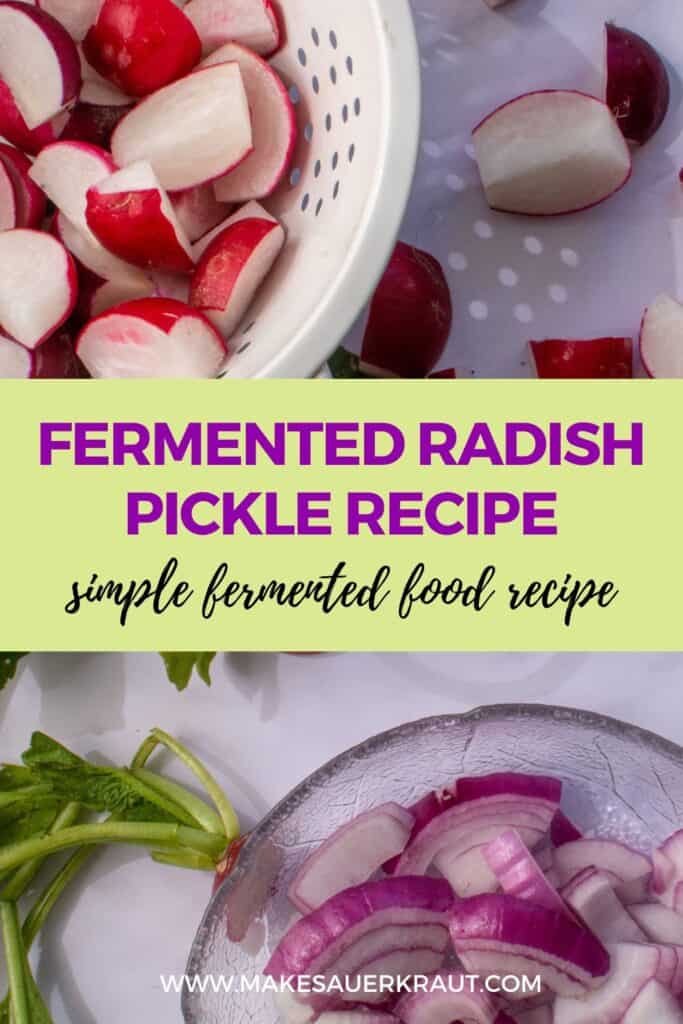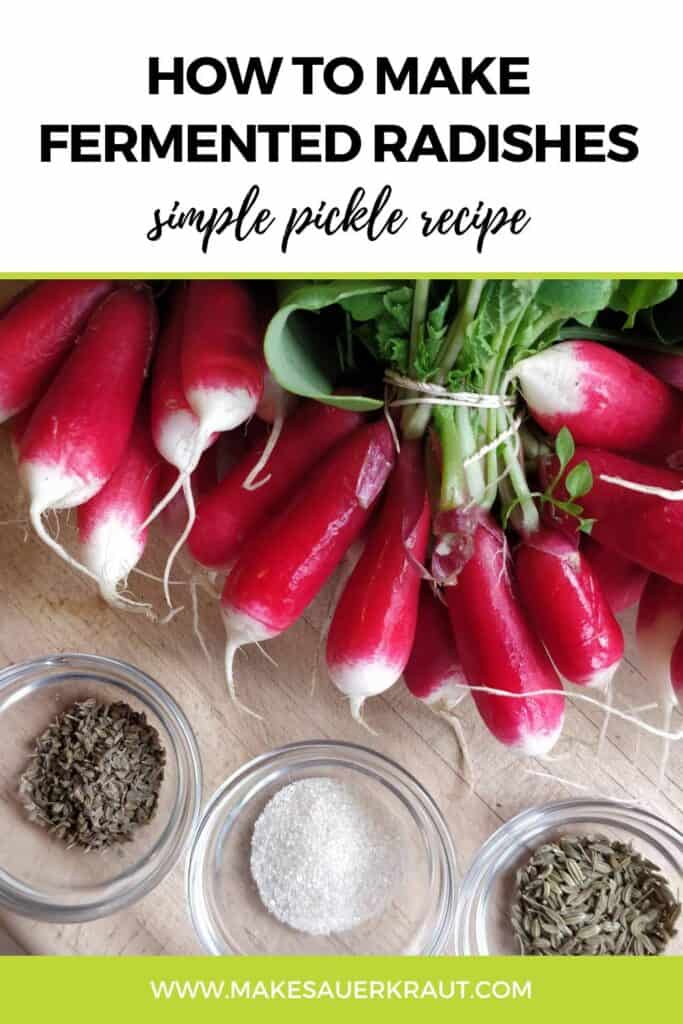Discover the art of transforming fresh-picked radishes into gut-healing superfoods! I’ll show you how to create flavorful fermented radishes effortlessly. Enhance salads, top tacos, or enjoy them as a crunchy snack. Join me on this fermentation journey, become a Fermentation Ninja, and unlock affordable probiotics in every bite.
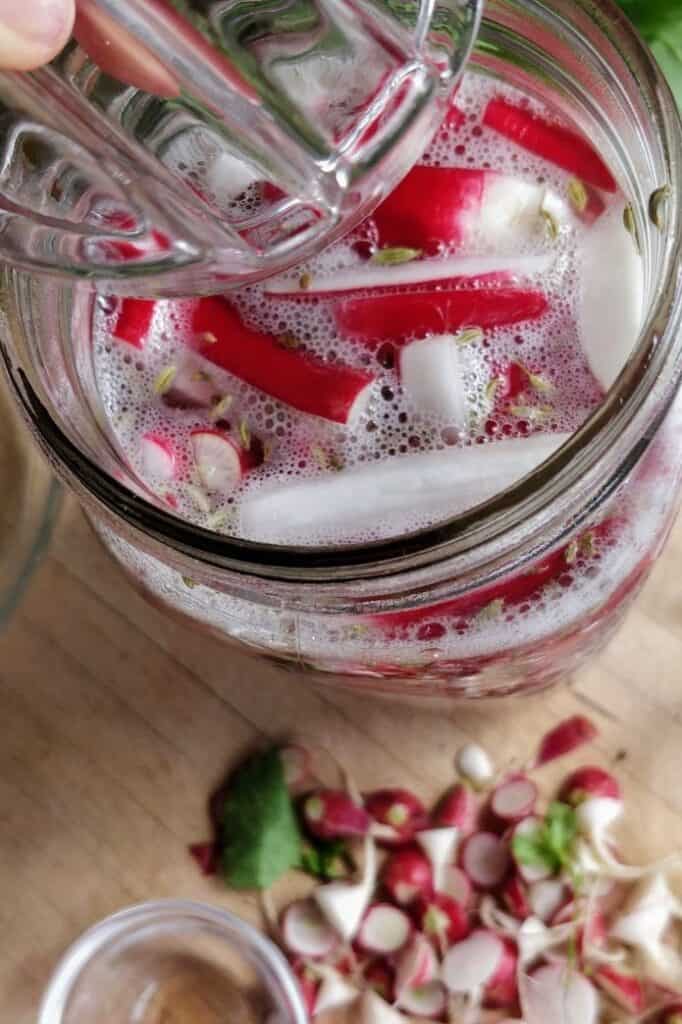
Today I’m going to show you just how simple it is to transform fresh-picked radishes into gut-healing superfoods that can be added to a salad, used as a topping for tacos, or crunched on for a snack.
I spent a few summers perfecting my “Perfect Pickle Process” to create flavorful fermented vegetables with just the right texture and tang… batch after batch.
Krowning how much salt to use, the best temperature for fermentation, and how to avoid mold and yeast growth can transform you into a Fermentation Ninja in no time.
Fermented radishes, along with naturally fermented carrots, cucumber pickles, or beets are delicious, easy to make, and an inexpensive way to get probiotics into your diet.
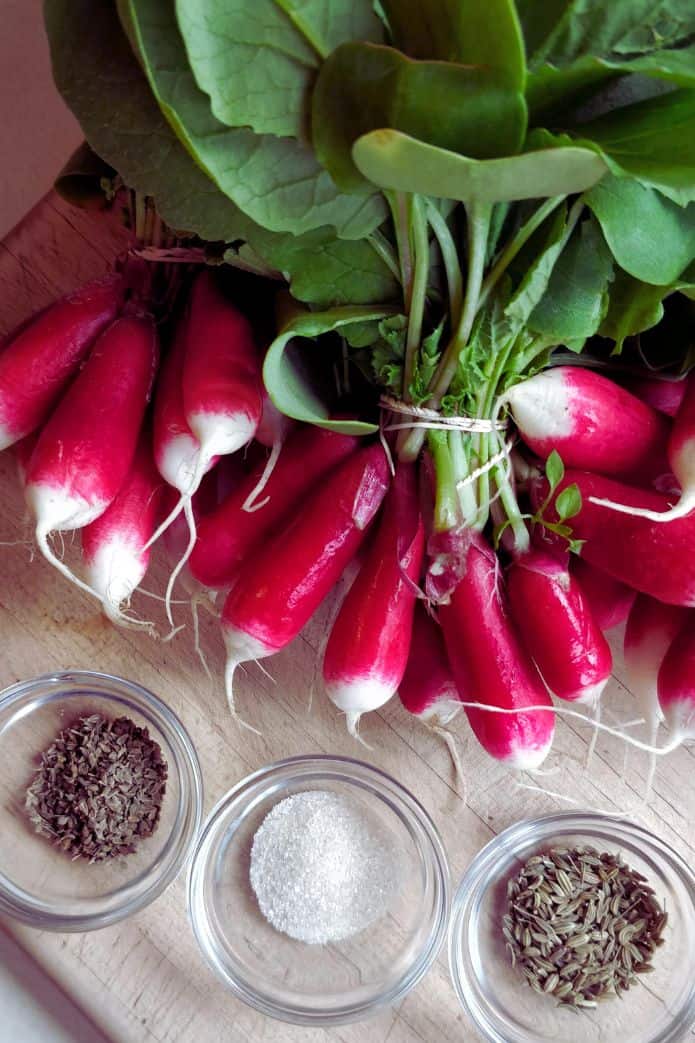
Fermented radishes are a great ferment for first-time fermenters.
Rarely does something go wrong during fermentation,
And…
They’re ready in a short time.
Before I get to the recipe, let me share a few benefits:
Benefits of Fermented Radishes
There are several reasons why you might consider fermenting radishes:
- Improved digestion. Fermenting radishes, and other vegetables, breaks down their fibers, and makes them easier to digest.
- Enhanced flavor. Fermenting radishes brings out their natural sweetness and tanginess and adds a pleasant sourness. The result is a unique and delicious flavor that enhances the taste of your meals.
- Increased nutritional value. Fermentation increases the bioavailability of certain nutrients, such as vitamin C. This means that your body can better absorb and utilize these nutrients.
- Extended shelf life. Fermenting radishes extends their shelf life. Ferment them when in season, enjoy them all year. A perfect way to extend the harvesting season!
Fermenting radishes can be a fun and delicious way to experiment with fermentation and add a unique twist to your meals while providing potential health benefits.
How to Make Fermented Radishes
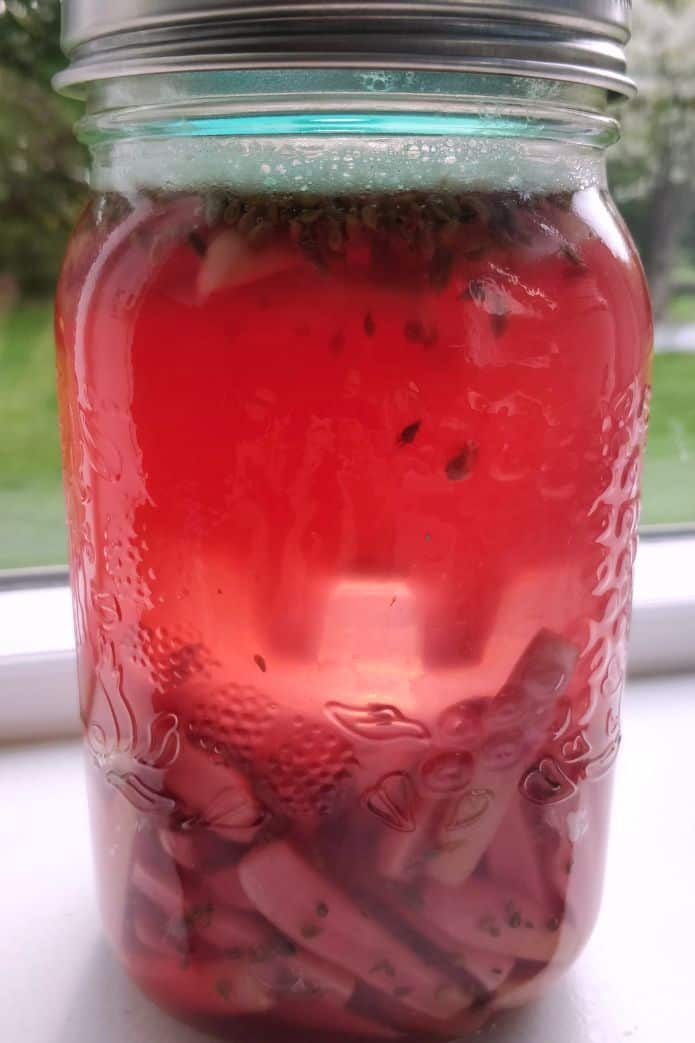
First Off, Don’t Use a Brine Chart
My recipe for naturally fermented vegetables is different than most of the other recipes on the internet that rely upon numbers off a brine chart.
Most recipes have you pack your jar with vegetables, mix a salty brine, and then pour that into the jar.
Results will vary greatly because the weight of the vegetables you packed into the jar varies greatly.
As I researched and developed recipes for my In A Pickle! online course, I realized that you can’t have consistent, safe, mold-free results by just pouring a salty brine into a jar of packed vegetables.
The bacteria responsible for fermentation, need a set salt concentration to create the lactic acid necessary for a safe ferment.
You have to know the weight of both the vegetables and the water in your jar and calculate your salt based on that.
Once you know this weight, you multiply it by the recommended salt concentration for the vegetables being fermented and then add the correct number of grams of salt to the jar.
Don’t worry, it’s simple to do and I’ll take you through it step by step.
Salt Concentration Chart FREE Download
Use the button below to get your own printable Salt Concentration Chart.
First, gather your ingredients, chose a flavoring options, see the recipe in pictures, and then reveiw my tips for success
Gather Ingredients
- Radishes. Fresh, local, and organic, if possible. In this recipe I used the commonly found red radish. Bunches should feel firm with bright, green leaves.
- Salt. Iodine-free salt is best. I like to use a mineral-rich, unprocessed salt: Real Salt or Himalayan pink salt.
- Pure Water. Chlorine-free water is best as chlorine can interfere with the fermentation process.
- Seasonings. Chose from the flavoring options below.
Choose a Flavoring Option
Fermented radishes have a tangy, slightly sour flavor that can be enhanced with various flavorings. Here are some ideas for flavoring fermented radishes:
- Garlic. Adding garlic to your fermented radishes can give them a delicious and aromatic flavor.
- Herbs. Adding fresh herbs such as dill, thyme, or basil can give your fermented radishes a unique and delicious flavor.
- Spices. Spices such as anise, fennel, cumin, coriander, or mustard seeds can add a complex and flavorful dimension to your fermented radishes.
- Citrus. A squeeze of fresh lemon or lime juice can add a bright, zesty flavor to your fermented radishes.
Experiment with different flavorings to find your favorite combination and enjoy the delicious and nutritious benefits of fermented radishes.
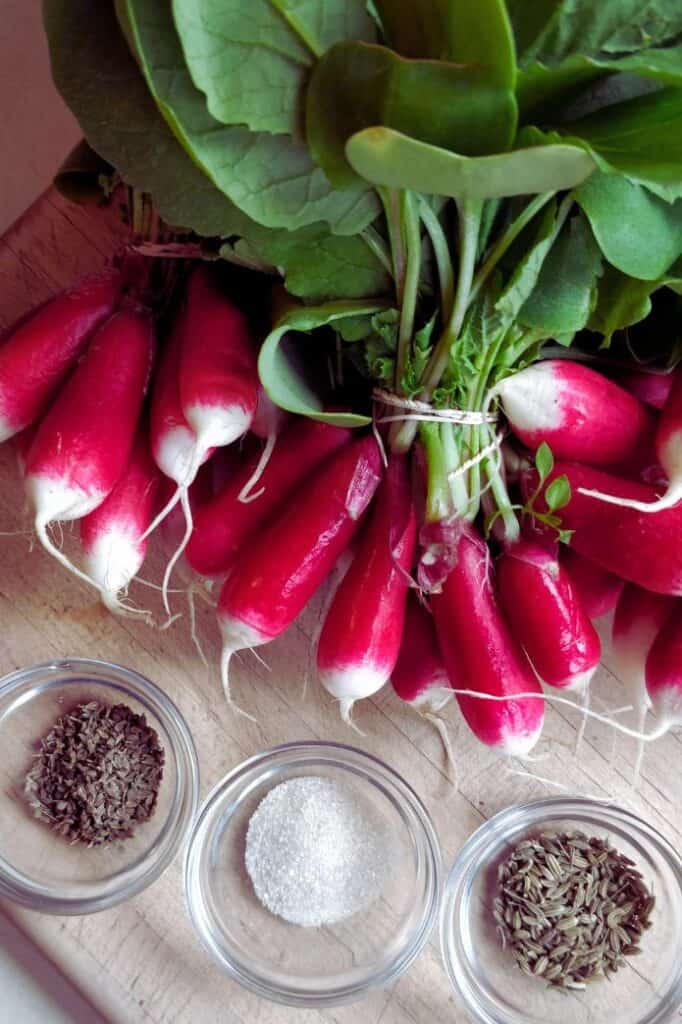
Gather Ingredients
Fresh radishes are your best choice. Look for bunches with bright green leaves and radishes that feel solid. Select and prepare flavoring option.
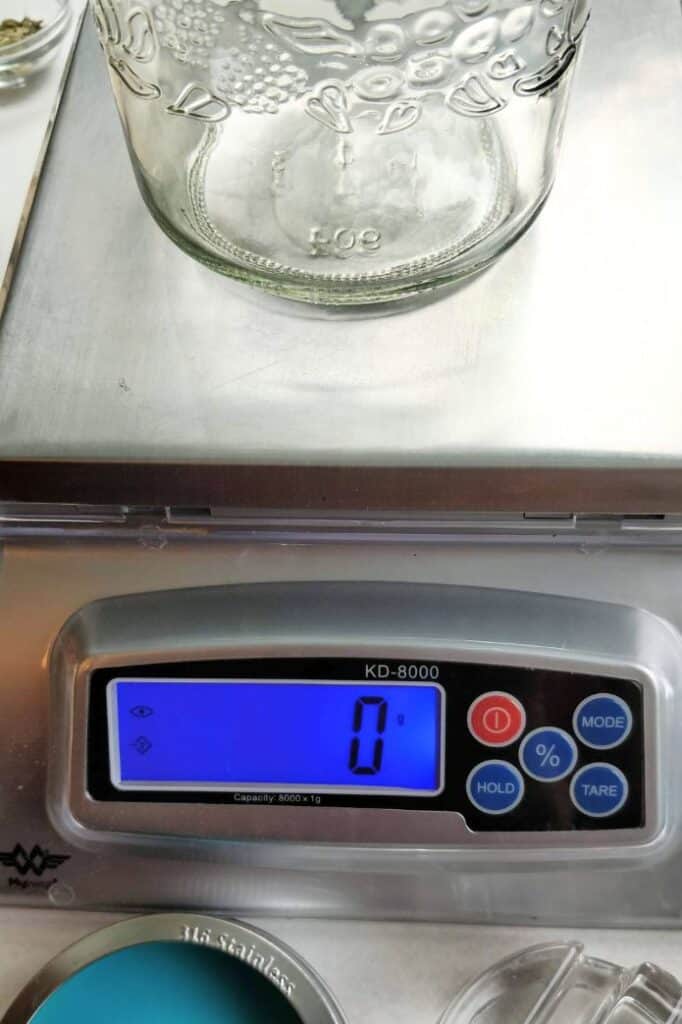
Weigh Jar
Place jar on scale and Tare (zero out), OR, obtain the weight—tare—of your jar (471 grams, for example). Write this number down.
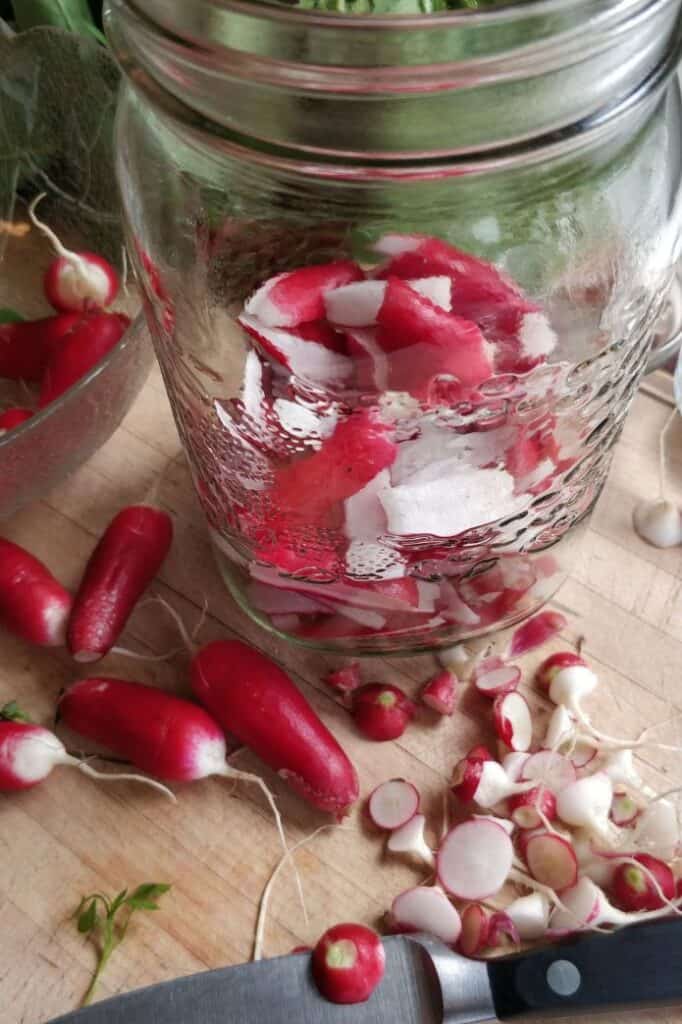
Prepare Radishes
Remove tops and tails. Rinse clean. Then, quarter radishes into wedges or slice no thinner than 1/4 inch. You want chunks, not thin slices which fermenter too quickly.
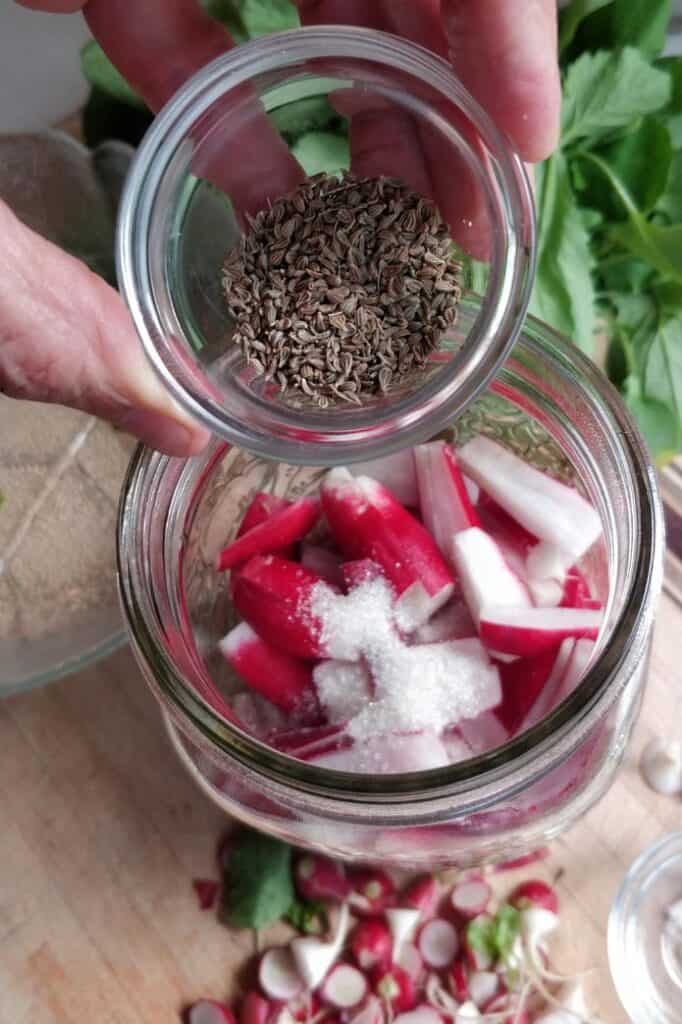
Add Flavor Option
Garlic, onions, dill, and various spices can all be used to flavor your fermented radishes. In the recipe below, I give you several suggestions.
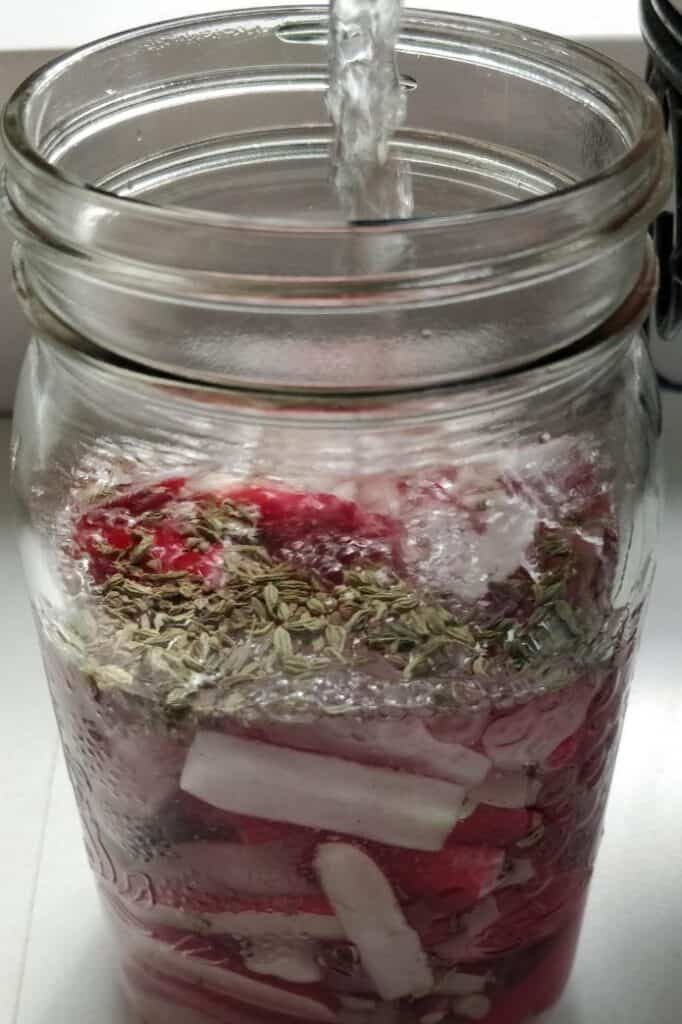
Fill Jar with Water
Pour water into the jar, stopping 1-2 inches below the threads of the jar.
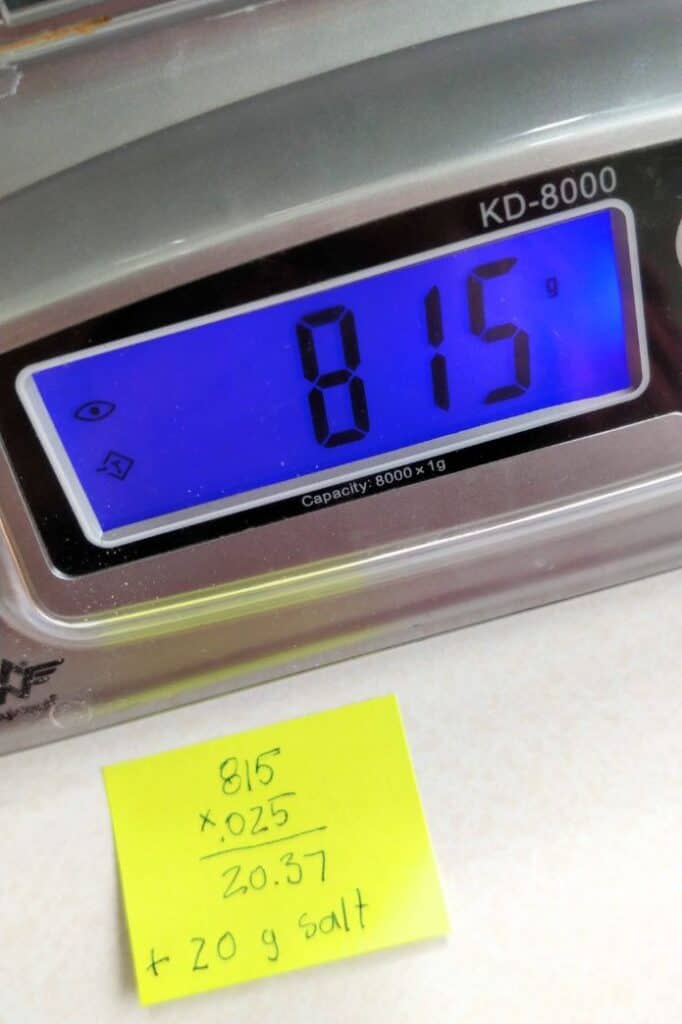
Obtain Weight of Veggies + Water
In this example, using the MyWeigh KD8000 scale, the weight for the radishes AND the water is 815 grams.
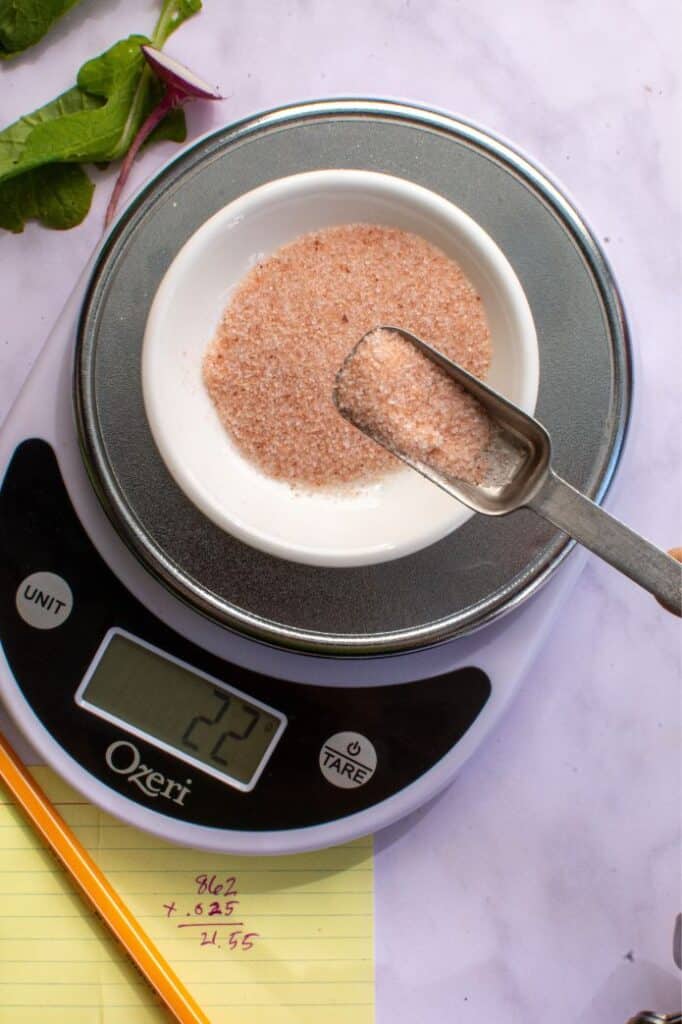
Calculate & Add Correct Grams of Salt
Radishes require a 2.5% total salt concentration.
Multiply the weight of the contents in your jar by 0.025 (815 x. 0.025 = 20.37, for example).
Tare a small dish and weigh the correct grams of salt (20 grams, for example).
Add this salt to your jar of radishes. Screw on the canning lid and rim that came with your jar and shake for one minute to dissolve the salt.
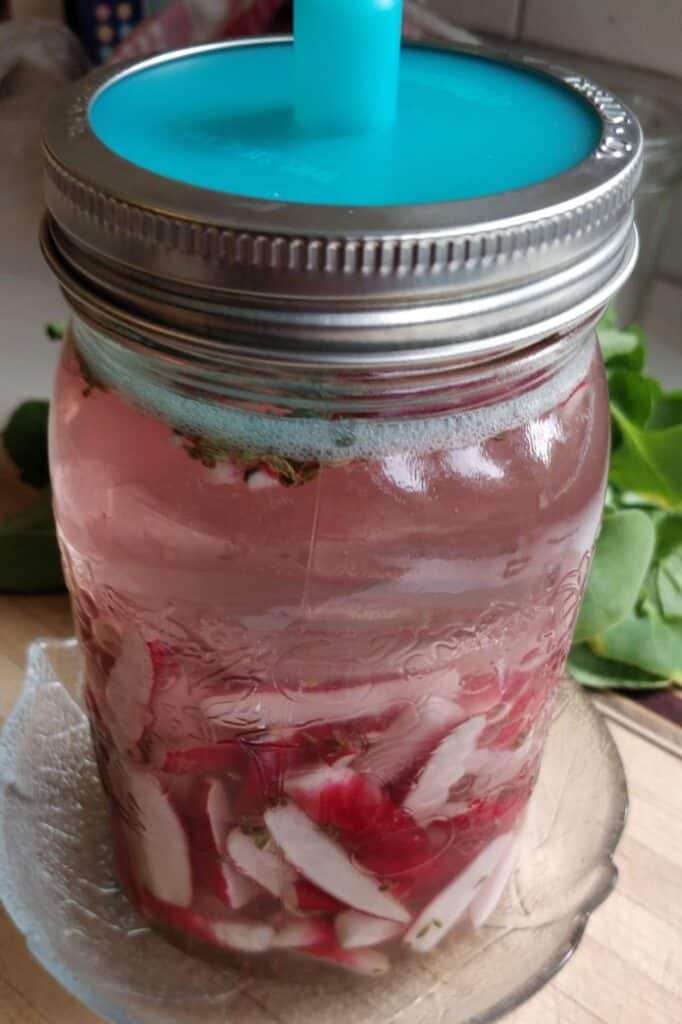
Radishes Ready for Fermentation
Remove the canning lid and rim used to shake and dissolve salt.
Add a fermentation weight and screw a fermentation lid on snugly, or a plastic lid left a tad loose. Place your jar in a shallow dish on your counter out of direct sunlight to ferment for 7-14 days.
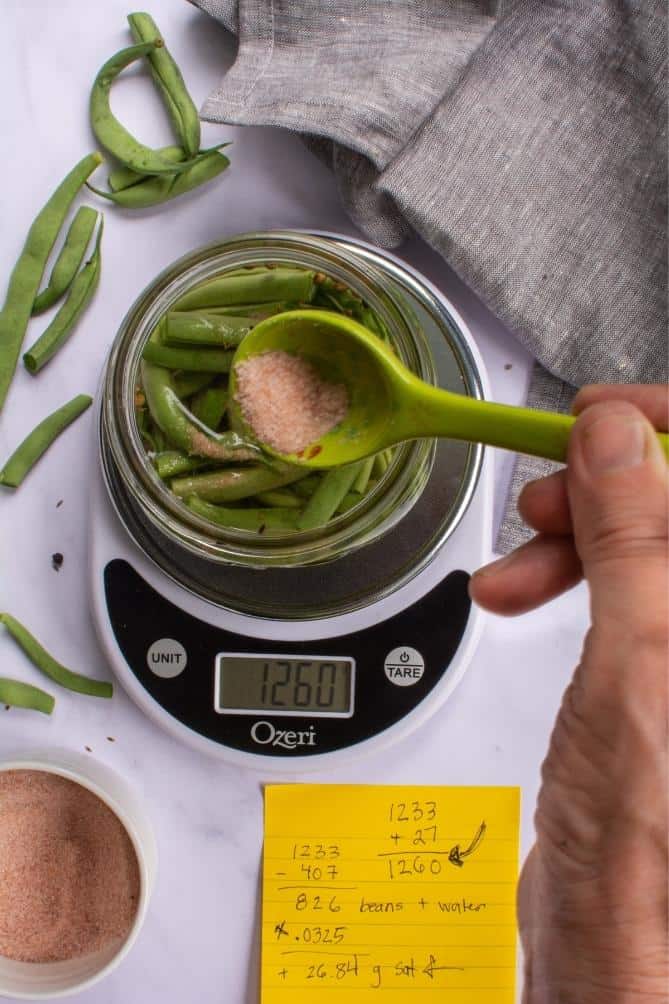
Get ready to be surprised by the wide variety of pickles you can safely & easily preserve at home.
Learn the Perfect Pickle Process in my online program and “grow” your own probiotic-rich superfoods. YUM!
Tips to Successfully Ferment Radishes
- Use a 2.5% total salt concentration.
Use 2.5% salt by weight for the weight of both the vegetables and the water in your jar. - My favorite salt for fermentation is Himalayan Pink.
I talk about the best salt for fermentation here. In short, use non-iodized salt. - Calculate and make fresh brine for each batch of fermented radishes.
See my recent post on why I say: Don’t reuse the brine—or feel you need to use a starter. - Below the brine.
For worry-free fermentation, it is best to use some sort of weight to hold the radishes below the brine. - No airlock?
Airlocks allow excess gases to escape. If you don’t have an airlock and you want to be super safe, burp the jar once daily during the first 3 days. - Adjust fermentation time based on ambient room temperature and desired product.
Ideal fermentation temperature is 65-70°F (18-21°C).
Adjust the length of fermentation based on the temperature of your kitchen. If it is super hot, shorten; cold, lengthen. - Agitate brine DAILY! Kahm yeast (harmless but can impart a yeasty flavor) can grow on the surface of ferments, usually with vegetables high in sugars. You usually want see it with radishes, but to be on the safe side jostle the jar daily to disturb the surface of the brine.
- Eat the fermented flavoring items.
When using garlic, ginger, hot peppers, etc. to add flavor to your ferment, you are also fermenting those items and they can be eaten as well. - Drink leftover fermented brine, or use it to make salad dressings.
- Keep your fermented radishes handy.
My fermented vegetables greet me front and center when I open the refrigerator and are just begging to be snacked on. You might need to do likewise so they are not forgotten somewhere in the back of your refrigerator.
Frequently Asked Questions
You can ferment various types of radishes: red, daikon, watermelon, etc. Just be sure to cut them into wedges or slices of similar thickness so that they ferment evenly.
They can be elusive. Tilt the jar to the side to see if any are sitting on the surface of the brine. Look for other signs of fermentation: colors fading, sour taste, vinegar-like aroma.
Feel free to taste them along the way. The radishes are ready when bubbles have stopped rising to the surface, there is a slightly sour aroma and they taste tangy.
Ideal fermentation temperature is 65-70°F (18-21°C).
Adjust the length of fermentation based on the temperature of your kitchen. If it is super hot, shorten; cold, lengthen.
Agitate brine DAILY! Kahm yeast (harmless but can impart a yeasty flavor) can grow on the surface of ferments, usually with vegetables high in sugars. You usually want see it with radishes, but to be on the safe side jostle the jar daily to disturb the surface of the brine.
My Five Favorite Fermentation Tools
Fermented Radishes Recipe
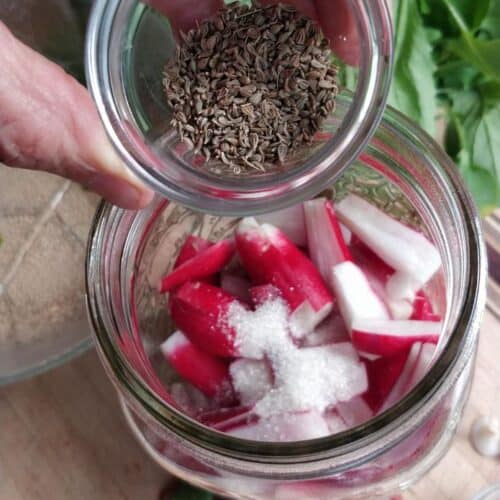
EQUIPMENT
- 1 quart jar
- fermentation weight
- airlock
- canning lid and rim
INGREDIENTS
- 2-3 bunches radishes, 400-500g prepared
- 1 tsp sugar, (Balances the bite from the radishes.)
- Iodine-free salt (fine-grain)
- Non-chlorinated water
FLAVORING OPTIONS [Choose from one of the following]
- 1 tsp fennel seeds + 1 tsp anise seeds
- 1-3 garlic cloves, peeled and cut into slivers
- 1 teaspoon dried dill, (1 tablespoon fresh)
- 1 sliced green onion, plus a bit of sliced red onion
INSTRUCTIONS
- PREP FLAVORING ITEM.Prep what you'll be using to flavor your radishes.
- PREP RADISHES.Remove tops and tails. Rinse clean. Then, quarter radishes into wedges or slice no thinner than 1/4 inch. You want chunks, not thin slices which.
- WEIGH JAR.Use a digital scale to obtain the weight—tare—of your jar (471 grams, for example). Write this number down.
- PACK JAR.Add 1 teaspoon of sugar to the jar (cuts the bite from the radishes, optional.)Place what you'll be using to flavor your radishes sticks in the bottom of your jar then snugly pack radishes into the jar leaving one inch of head space.
- TOP WITH WATER. Pour water over radishes letting it percolate down.
- CALCULATE & ADD 2.5% SALT.Weigh your packed jar. The number on the scale is the weight of the jar, plus the weight of the vegetables and the water (1286 grams, for example).Subtract the jar weight from the total weight (1286 – 471 = 815, for example).Multiply the weight of the contents in your jar by 0.025 (851 x. 0.025 = 20.3, for example).Tare a small dish and weigh the correct grams of salt (20 grams, for example).Add this salt to your jar of radishes.
- DISSOLVE SALT.Screw on a standard canning jar lid and rim and tightly secure. Shake the jar for a couple of minutes to dissolve the salt.Remove lid.
- SUBMERGE & SEAL.Add a fermentation weight to keep the vegetables submerged under the brine. Close the jar either with an airlock or with a lid left loose enough to allow CO2 to escape.
- FERMENT.Label with recipe name, date, and salt concentration. Place in a shallow bowl on your kitchen counter, out of direct sunlight to ferment until active bubbling stops, usually, 7-14 days depending upon the temperature of your room. The color from the radishes will turn the brine a beautiful pink, which sadly fades over time. Feel free to taste them along the way. The radishes are ready when bubbles have stopped rising to the surface, there is a slightly sour aroma and they taste tangy.
- STORE.Add the fermentation length to your label and put in the refrigerator. Your fermented radishes may be eaten immediately, but will increase in flavor with time and will keep for up to a year, though they lose color as the months go on.
Notes and Tips
- My favorite salt for fermentation is Himalayan Pink. I talk about the best salt for fermentation here, here. In short, use non-iodized salt.
- Flavoring your radishes. Experiment with different flavorings to find your favorite combination.
- Below the brine. For worry-free fermentation, it is best to use some sort of weight to hold the radishes below the brine.
- No airlock? Airlocks allow excess gases to escape. If you don’t have an airlock, burp the jar once daily during the first 3 days.
- Adjust fermentation time based on ambient room temperature and desired product. The ideal fermentation temperature is 65-70°F (18-21°C) is ideal. If it is super hot, shorten; cold, lengthen.
- Do drink leftover fermented brine, or use it to make salad dressings.
Ways to Eat Fermented Radishes
Enjoy your delicious fermented radishes as a snack or use them as a flavorful topping for salads, tacos, sandwiches, or rice bowls.
Fermented radishes can be enjoyed in many ways! Here are some ideas:
Eat them as a snack. Fermented radishes make a delicious and nutritious snack on their own. Just grab a few slices and enjoy!
Add them to salads. Fermented radishes add a tangy crunch to salads, especially when paired with leafy greens and a flavorful dressing.
Use them as a topping. Fermented radishes make a great topping for tacos, sandwiches, rice bowls, or any dish that could use a pop of flavor.
Mix them into dips. Fermented radishes can be chopped up and mixed into dips like hummus, guacamole, or yogurt dip for a tangy twist.
Blend them into dressings. Pureeing fermented radishes into dressings can add a delicious tangy flavor and creamy texture.
Experiment with different ways of enjoying fermented radishes and find your favorite way to incorporate them into your meals!
Salt Concentration Chart FREE Download
Use the button below to get your own printable Salt Concentration Chart.
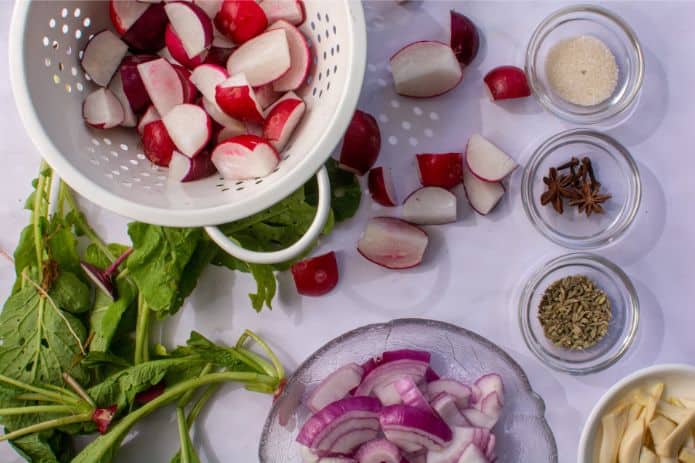
Last update on 2024-07-26 / Affiliate links / Images from Amazon Product Advertising API

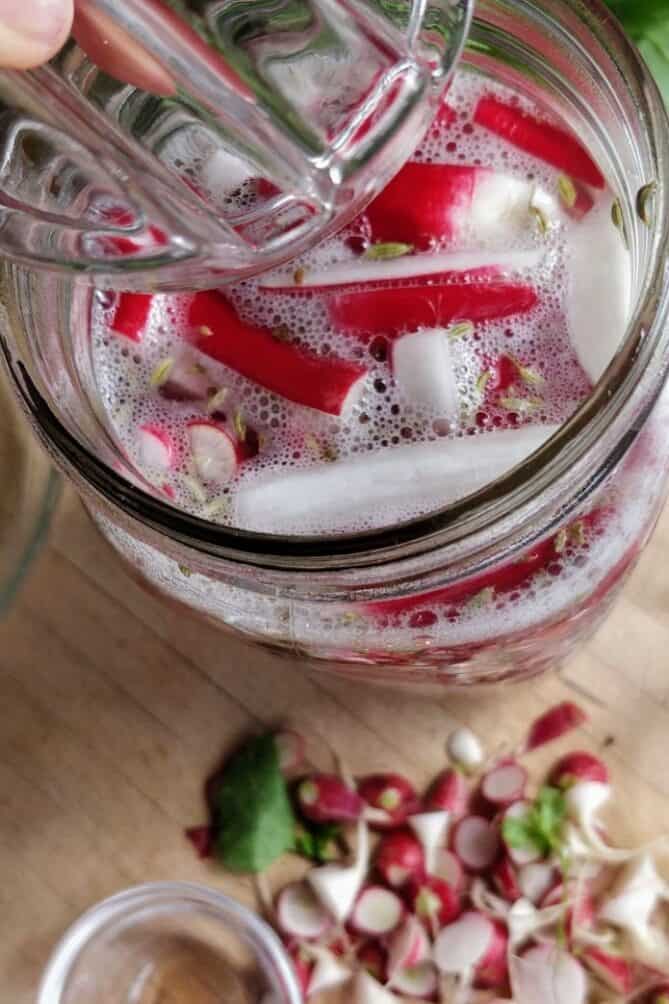

 This post may contain affiliate links which won’t change your price but will share some commission.
This post may contain affiliate links which won’t change your price but will share some commission.